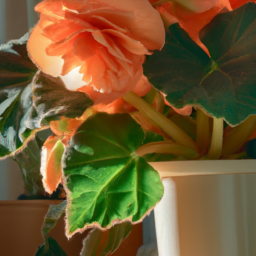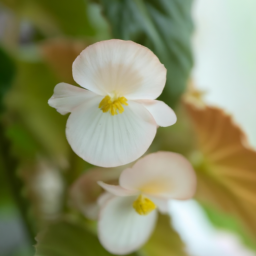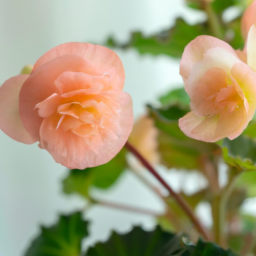
Are you looking to add a pop of color and life to your indoor space? Indoor begonia varieties may be just what you need! Begonias are a popular choice for indoor plants due to their beautiful foliage and vibrant blooms. In this blog post, we will explore some of the most popular indoor begonia varieties and provide tips on how to care for these stunning plants. So sit back, relax, and let’s dive into the world of indoor begonias!
Popular Indoor Begonia Varieties for Home Gardening
Introduction
When it comes to indoor plants, begonias are a popular choice for home gardeners. With their colorful flowers and unique foliage, begonias can add a touch of beauty to any indoor space. There are many different varieties of begonias to choose from, each with its own unique characteristics and care requirements. In this guide, we will explore some of the most popular indoor begonia varieties and provide tips on how to care for them.
Rex Begonias
Rex begonias are known for their stunning foliage, which comes in a wide range of colors and patterns. These begonias are prized for their large, showy leaves that can be variegated with shades of silver, pink, purple, and green. Rex begonias are a great choice for indoor gardening, as they prefer bright, indirect light and high humidity. To care for your rex begonia, be sure to keep the soil consistently moist but not waterlogged, and fertilize regularly during the growing season.
Another popular indoor begonia variety is the Angel Wing begonia. These begonias are named for their unique wing-shaped leaves that hang gracefully from the stems. Angel Wing begonias produce clusters of delicate flowers in shades of pink, red, or white, adding a touch of elegance to any indoor space. To care for your Angel Wing begonia, place it in a bright location with indirect sunlight and water it when the top inch of soil feels dry. Be sure to fertilize your Angel Wing begonia every two weeks during the growing season to encourage healthy growth and blooming.
Tuberous Begonias
Tuberous begonias are another popular choice for indoor gardening, thanks to their showy flowers that come in a wide range of colors. These begonias produce large, double blooms that can be white, pink, red, or orange, making them a colorful addition to any indoor garden. Tuberous begonias prefer bright, indirect light and well-draining soil, so be sure to place them in a sunny spot and water them when the top inch of soil feels dry. Fertilize your tuberous begonias every two weeks during the growing season to promote healthy blooming.
In conclusion, there are many different varieties of begonias to choose from for indoor gardening, each with its own unique characteristics and care requirements. Whether you prefer the stunning foliage of rex begonias, the elegant flowers of Angel Wing begonias, or the colorful blooms of tuberous begonias, there is a begonia variety to suit every indoor space. By following the care tips outlined in this guide, you can enjoy beautiful begonias in your home all year round.

Care Tips for Different Indoor Begonia Varieties
Rex Begonias
Rex begonias are known for their stunning foliage, which comes in a variety of colors and patterns. These plants prefer bright, indirect light and should be kept away from direct sunlight, as it can scorch their leaves. Keep the soil consistently moist, but not soggy, and use a well-draining potting mix to prevent root rot. Rex begonias thrive in high humidity, so consider placing a humidifier near their location or misting them regularly.
To encourage healthy growth, fertilize your rex begonias every 2-4 weeks during the growing season with a balanced fertilizer diluted to half strength. Prune any leggy or yellowing leaves to promote new growth and maintain a bushy appearance. Keep an eye out for pests like spider mites and mealybugs, and treat them promptly with neem oil or insecticidal soap.
Propagation of rex begonias can be done through leaf cuttings or division. To propagate through leaf cuttings, simply cut a healthy leaf with a petiole attached and place it in a pot of moist soil. Keep the soil consistently moist and within a few weeks, new roots and shoots should begin to emerge. Division can be done by separating the rhizomes of mature plants and planting them in individual pots.
Cane Begonias
Cane begonias, also known as angel wing begonias, are prized for their elegant, arching stems and clusters of delicate flowers. These plants prefer bright, indirect light and should be kept away from drafts and cold temperatures. Water cane begonias when the top inch of soil feels dry, and be sure to empty any excess water from the saucer to prevent root rot.
Fertilize cane begonias every 4-6 weeks during the growing season with a balanced fertilizer diluted to half strength. Prune leggy stems to promote new growth and maintain a compact shape. Keep an eye out for pests like aphids and scale insects, and treat them promptly with neem oil or insecticidal soap.
Propagation of cane begonias can be done through stem cuttings. Simply cut a healthy stem with at least one node and place it in a pot of moist soil. Keep the soil consistently moist and within a few weeks, new roots should begin to form. Once the cutting has established roots, it can be potted up into its own container.
Tuberous Begonias
Tuberous begonias are known for their showy, rose-like flowers in a range of vibrant colors. These plants prefer bright, indirect light and should be protected from direct sunlight, as it can scorch their delicate blooms. Water tuberous begonias when the top inch of soil feels dry, and be sure to avoid getting water on the leaves to prevent fungal diseases.
Fertilize tuberous begonias every 2-4 weeks during the growing season with a high-potassium fertilizer diluted to half strength. Deadhead spent flowers regularly to encourage continuous blooming and remove any yellowing or damaged leaves. Keep an eye out for pests like thrips and spider mites, and treat them promptly with neem oil or insecticidal soap.
Propagation of tuberous begonias can be done through division of tubers. Simply separate the tubers into individual sections, making sure each section has an eye or growth point. Plant the tubers in a well-draining potting mix with the eyes facing up, and keep the soil consistently moist. Within a few weeks, new shoots should begin to emerge, indicating successful propagation.

How to Propagate Indoor Begonia Varieties from Cuttings
Introduction
Propagating indoor begonia varieties from cuttings is a great way to expand your collection of these beautiful plants. Begonias are known for their colorful foliage and flowers, making them a popular choice for indoor gardens. By following a few simple steps, you can easily propagate new plants from cuttings taken from your existing begonias.
Gathering Supplies
Before you begin the propagation process, you will need to gather a few supplies. You will need a sharp pair of scissors or pruning shears, a clean container filled with potting mix, a plastic bag or plastic wrap, and a spray bottle filled with water. It is also helpful to have some rooting hormone on hand to encourage the cuttings to develop roots more quickly.
To start the propagation process, select a healthy begonia plant that you would like to take cuttings from. Look for a stem that is about 4-6 inches long and has several leaves on it. Use your scissors or pruning shears to make a clean cut just below a leaf node, which is where a leaf meets the stem. This will give you a cutting that is more likely to develop roots.
Once you have taken your cutting, remove the lower leaves from the stem, leaving only a few at the top. This will help prevent the cutting from losing too much moisture as it develops roots. Dip the cut end of the stem into the rooting hormone, then gently tap off any excess.
Planting and Caring for Cuttings
After you have prepared your cutting, it is time to plant it in the potting mix. Make a small hole in the soil with your finger or a pencil, then insert the cutting into the hole. Gently press the soil around the cutting to secure it in place. Mist the cutting with water from the spray bottle to help it settle into its new home.
Once the cutting is planted, cover the container with a plastic bag or plastic wrap to create a humid environment. This will help prevent the cutting from drying out as it develops roots. Place the container in a warm, bright location, but out of direct sunlight.
Check the cutting regularly to make sure the soil stays moist. You can mist the cutting with water as needed to keep it hydrated. After a few weeks, you should start to see new growth emerging from the cutting, which is a sign that roots are forming.
In about 4-6 weeks, the cutting should have developed a healthy root system and can be transplanted into a larger pot. Care for the new plant as you would any other begonia, providing it with regular water, bright light, and occasional fertilization.
By following these simple steps, you can successfully propagate indoor begonia varieties from cuttings and expand your collection of these beautiful plants. Enjoy watching your new plants grow and thrive in your indoor garden!
Let’s wrap up what we learned
If you’re looking to add some greenery to your indoor space, begonias are a beautiful and versatile option to consider. With a wide range of varieties to choose from, you can find the perfect begonia to suit your style and space. From the popular Rex begonias with their stunning foliage patterns to the classic Angel Wing begonias with their elegant hanging clusters of flowers, there is a begonia for every taste.
Indoor begonias are relatively low maintenance plants that thrive in bright, indirect light and well-draining soil. With proper care, they can bring a pop of color and texture to any room in your home. Whether you’re a seasoned plant parent or just starting out, indoor begonias are a great choice for adding some natural beauty to your indoor space.
Here are some FAQs you’d be interested in:
Q1. What are some popular indoor begonia varieties?
A1. Some popular indoor begonia varieties include Rex begonias, Angel wing begonias, and Iron cross begonias. Each variety has its own unique characteristics and care requirements.
Q2. How do I care for indoor begonias?
A2. Indoor begonias thrive in bright, indirect light and well-draining soil. They prefer moderate humidity levels and should be watered when the top inch of soil feels dry. Regularly misting the leaves can also help maintain humidity levels.
Q3. Can indoor begonias be grown from seeds?
A3. While indoor begonias can be grown from seeds, it is more common to propagate them through stem or leaf cuttings. This method ensures that the new plants will have the same characteristics as the parent plant.
Q4. Are indoor begonias safe for pets?
A4. Some indoor begonia varieties can be toxic to pets if ingested. It is important to keep them out of reach of curious pets or choose non-toxic varieties if you have animals in your home.
Q5. How can I encourage indoor begonias to bloom?
A5. To encourage indoor begonias to bloom, provide them with the right conditions, including proper lighting, humidity, and temperature. Regularly fertilizing them during the growing season can also help promote flowering.
Dr. Olivia Green is a botanist with over two decades of experience in indoor plant cultivation. She holds a Ph.D. in Plant Biology and has dedicated her career to researching plant behavior in controlled environments. Dr. Green is passionate about helping plant enthusiasts master the art of indoor gardening through her extensive knowledge and practical insights.


